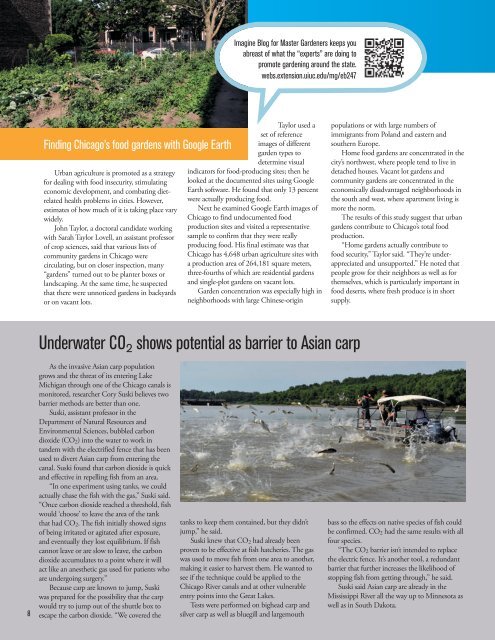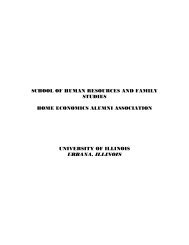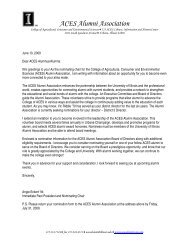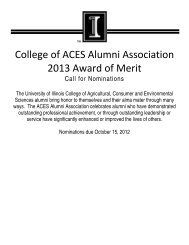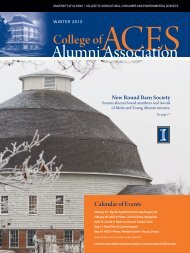Summer 2013 - ACES Alumni Association
Summer 2013 - ACES Alumni Association
Summer 2013 - ACES Alumni Association
You also want an ePaper? Increase the reach of your titles
YUMPU automatically turns print PDFs into web optimized ePapers that Google loves.
Imagine Blog for Master Gardeners keeps you<br />
abreast of what the “experts” are doing to<br />
promote gardening around the state.<br />
webs.extension.uiuc.edu/mg/eb247<br />
Finding Chicago’s food gardens with Google Earth<br />
Urban agriculture is promoted as a strategy<br />
for dealing with food insecurity, stimulating<br />
economic development, and combating dietrelated<br />
health problems in cities. However,<br />
estimates of how much of it is taking place vary<br />
widely.<br />
John Taylor, a doctoral candidate working<br />
with Sarah Taylor Lovell, an assistant professor<br />
of crop sciences, said that various lists of<br />
community gardens in Chicago were<br />
circulating, but on closer inspection, many<br />
“gardens” turned out to be planter boxes or<br />
landscaping. At the same time, he suspected<br />
that there were unnoticed gardens in backyards<br />
or on vacant lots.<br />
Taylor used a<br />
set of reference<br />
images of different<br />
garden types to<br />
determine visual<br />
indicators for food-producing sites; then he<br />
looked at the documented sites using Google<br />
Earth software. He found that only 13 percent<br />
were actually producing food.<br />
Next he examined Google Earth images of<br />
Chicago to find undocumented food<br />
production sites and visited a representative<br />
sample to confirm that they were really<br />
producing food. His final estimate was that<br />
Chicago has 4,648 urban agriculture sites with<br />
a production area of 264,181 square meters,<br />
three-fourths of which are residential gardens<br />
and single-plot gardens on vacant lots.<br />
Garden concentration was especially high in<br />
neighborhoods with large Chinese-origin<br />
populations or with large numbers of<br />
immigrants from Poland and eastern and<br />
southern Europe.<br />
Home food gardens are concentrated in the<br />
city’s northwest, where people tend to live in<br />
detached houses. Vacant lot gardens and<br />
community gardens are concentrated in the<br />
economically disadvantaged neighborhoods in<br />
the south and west, where apartment living is<br />
more the norm.<br />
The results of this study suggest that urban<br />
gardens contribute to Chicago’s total food<br />
production.<br />
“Home gardens actually contribute to<br />
food security,” Taylor said. “They’re underappreciated<br />
and unsupported.” He noted that<br />
people grow for their neighbors as well as for<br />
themselves, which is particularly important in<br />
food deserts, where fresh produce is in short<br />
supply.<br />
Underwater CO 2 shows potential as barrier to Asian carp<br />
8<br />
As the invasive Asian carp population<br />
grows and the threat of its entering Lake<br />
Michigan through one of the Chicago canals is<br />
monitored, researcher Cory Suski believes two<br />
barrier methods are better than one.<br />
Suski, assistant professor in the<br />
Department of Natural Resources and<br />
Environmental Sciences, bubbled carbon<br />
dioxide (CO 2 ) into the water to work in<br />
tandem with the electrified fence that has been<br />
used to divert Asian carp from entering the<br />
canal. Suski found that carbon dioxide is quick<br />
and effective in repelling fish from an area.<br />
“In one experiment using tanks, we could<br />
actually chase the fish with the gas,” Suski said.<br />
“Once carbon dioxide reached a threshold, fish<br />
would ‘choose’ to leave the area of the tank<br />
that had CO 2 . The fish initially showed signs<br />
of being irritated or agitated after exposure,<br />
and eventually they lost equilibrium. If fish<br />
cannot leave or are slow to leave, the carbon<br />
dioxide accumulates to a point where it will<br />
act like an anesthetic gas used for patients who<br />
are undergoing surgery.”<br />
Because carp are known to jump, Suski<br />
was prepared for the possibility that the carp<br />
would try to jump out of the shuttle box to<br />
escape the carbon dioxide. “We covered the<br />
tanks to keep them contained, but they didn’t<br />
jump,” he said.<br />
Suski knew that CO 2 had already been<br />
proven to be effective at fish hatcheries. The gas<br />
was used to move fish from one area to another,<br />
making it easier to harvest them. He wanted to<br />
see if the technique could be applied to the<br />
Chicago River canals and at other vulnerable<br />
entry points into the Great Lakes.<br />
Tests were performed on bighead carp and<br />
silver carp as well as bluegill and largemouth<br />
bass so the effects on native species of fish could<br />
be confirmed. CO 2 had the same results with all<br />
four species.<br />
“The CO 2 barrier isn’t intended to replace<br />
the electric fence. It’s another tool, a redundant<br />
barrier that further increases the likelihood of<br />
stopping fish from getting through,” he said.<br />
Suski said Asian carp are already in the<br />
Mississippi River all the way up to Minnesota as<br />
well as in South Dakota.


